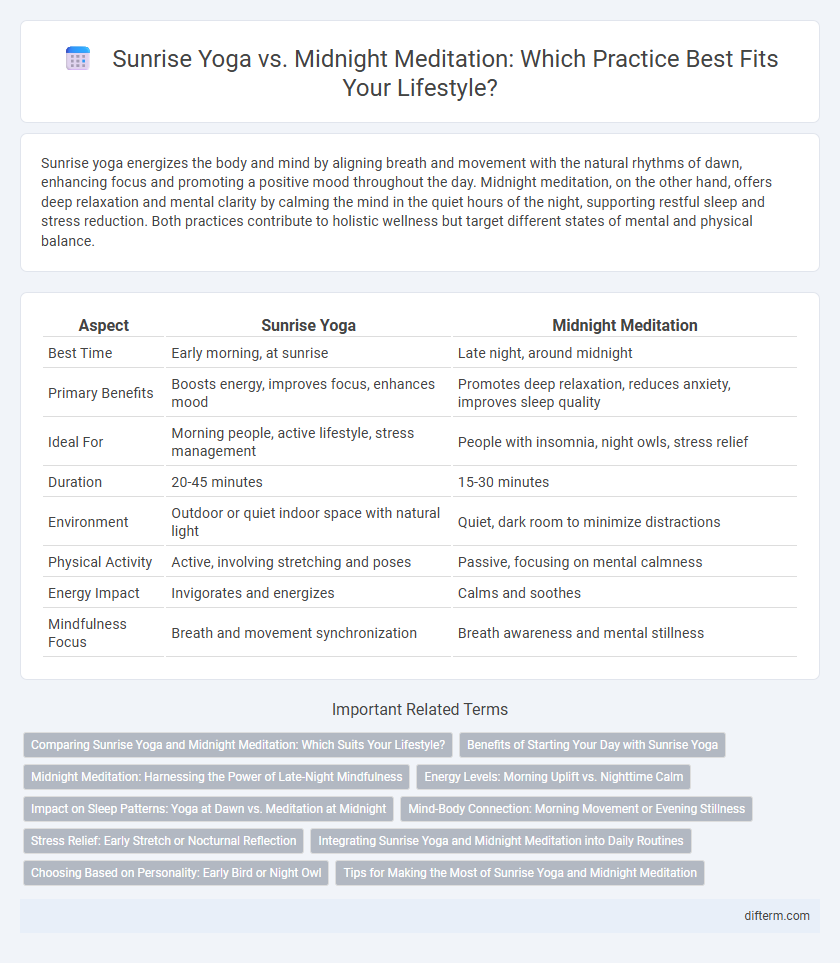Sunrise yoga energizes the body and mind by aligning breath and movement with the natural rhythms of dawn, enhancing focus and promoting a positive mood throughout the day. Midnight meditation, on the other hand, offers deep relaxation and mental clarity by calming the mind in the quiet hours of the night, supporting restful sleep and stress reduction. Both practices contribute to holistic wellness but target different states of mental and physical balance.
Table of Comparison
| Aspect | Sunrise Yoga | Midnight Meditation |
|---|---|---|
| Best Time | Early morning, at sunrise | Late night, around midnight |
| Primary Benefits | Boosts energy, improves focus, enhances mood | Promotes deep relaxation, reduces anxiety, improves sleep quality |
| Ideal For | Morning people, active lifestyle, stress management | People with insomnia, night owls, stress relief |
| Duration | 20-45 minutes | 15-30 minutes |
| Environment | Outdoor or quiet indoor space with natural light | Quiet, dark room to minimize distractions |
| Physical Activity | Active, involving stretching and poses | Passive, focusing on mental calmness |
| Energy Impact | Invigorates and energizes | Calms and soothes |
| Mindfulness Focus | Breath and movement synchronization | Breath awareness and mental stillness |
Comparing Sunrise Yoga and Midnight Meditation: Which Suits Your Lifestyle?
Sunrise yoga energizes the body and mind, boosting metabolism and promoting focus throughout the day, making it ideal for early risers seeking a natural wake-up routine. Midnight meditation enhances relaxation and stress relief, improving sleep quality and mental clarity for night owls or those with irregular schedules. Choosing between sunrise yoga and midnight meditation depends on your circadian rhythm and daily commitments, optimizing health benefits aligned with your lifestyle.
Benefits of Starting Your Day with Sunrise Yoga
Starting your day with sunrise yoga enhances mental clarity and boosts energy levels by aligning breath and movement in the fresh morning air. It triggers the release of endorphins, reducing stress hormones and fostering a positive mood for the day ahead. Unlike midnight meditation, sunrise yoga supports circadian rhythm regulation, promoting better sleep quality and overall well-being.
Midnight Meditation: Harnessing the Power of Late-Night Mindfulness
Midnight meditation cultivates deep mental clarity by leveraging the quiet solitude of late-night hours, enhancing stress reduction and promoting restorative sleep. Unlike sunrise yoga, which energizes the body for the day ahead, midnight meditation aligns with the body's natural circadian rhythm to improve emotional balance and introspection. Regular practice of late-night mindfulness techniques supports neuroplasticity and long-term mental well-being.
Energy Levels: Morning Uplift vs. Nighttime Calm
Sunrise yoga harnesses natural morning light to boost energy levels and invigorate the body, promoting alertness and positivity throughout the day. Midnight meditation fosters a calming environment that lowers cortisol levels, aiding relaxation and improved sleep quality. Choosing between the two depends on whether the goal is daytime vitality or nighttime tranquility.
Impact on Sleep Patterns: Yoga at Dawn vs. Meditation at Midnight
Sunrise yoga aligns with the body's natural circadian rhythm, promoting alertness and preparing the mind for the day, which can lead to improved sleep quality by establishing a consistent routine. Midnight meditation, however, helps activate the parasympathetic nervous system, reducing stress and anxiety that may interfere with falling asleep, but its timing may disrupt the body's internal clock if practiced too late. Both practices influence sleep patterns differently, with yoga enhancing daytime energy levels and meditation fostering relaxation for better nighttime rest.
Mind-Body Connection: Morning Movement or Evening Stillness
Sunrise yoga stimulates the mind-body connection by engaging muscles and enhancing circulation, preparing the body for daytime activity and boosting mental clarity. Midnight meditation fosters deep relaxation and introspection, promoting parasympathetic nervous system activation that aids in stress reduction and improved sleep quality. Choosing between morning movement or evening stillness depends on whether prioritizing energizing alertness or restorative calm aligns better with individual lifestyle and mental wellness goals.
Stress Relief: Early Stretch or Nocturnal Reflection
Sunrise yoga activates the body and mind with gentle stretching and increased blood flow, promoting natural cortisol regulation for effective stress relief. Midnight meditation enhances relaxation by calming the nervous system and lowering cortisol levels, fostering deep mental clarity and emotional balance. Choosing between early morning movement or late-night stillness depends on personal circadian rhythm and stress management goals.
Integrating Sunrise Yoga and Midnight Meditation into Daily Routines
Integrating sunrise yoga and midnight meditation into daily routines enhances mental clarity and physical vitality by aligning the body's natural circadian rhythms. Sunrise yoga activates the body with gentle stretching and breathwork to boost energy and focus for the day ahead, while midnight meditation promotes relaxation, stress reduction, and deeper sleep by calming the mind before bedtime. Combining both practices creates a balanced lifestyle that supports emotional well-being and optimal health throughout the 24-hour cycle.
Choosing Based on Personality: Early Bird or Night Owl
Early birds benefit from sunrise yoga by aligning physical energy with natural daylight, enhancing mood and productivity throughout the day. Night owls find midnight meditation effective for calming the mind, reducing stress after daily activities, and improving sleep quality. Selecting between these practices hinges on chronotype, optimizing mental and physical wellness according to individual circadian rhythms.
Tips for Making the Most of Sunrise Yoga and Midnight Meditation
Maximize the benefits of sunrise yoga by choosing a quiet, natural setting with minimal distractions to enhance mindfulness and energy flow. For midnight meditation, create a calming environment with dim lighting and comfortable seating to promote relaxation and deep mental clarity. Consistently practicing at these times helps regulate circadian rhythms and improves overall mental well-being.
sunrise yoga vs midnight meditation Infographic

 difterm.com
difterm.com